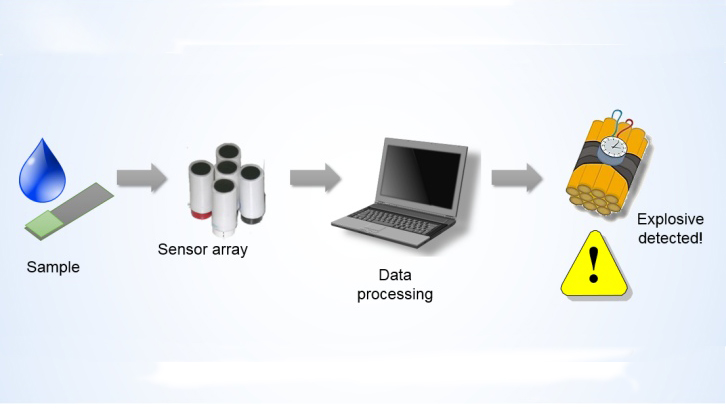An electronic tongue to identify hard to detect explosive compounds

This work is framed in the research carried out in the laboratories of the Sensors and Biosensor Group of the Universitat Autònoma de Barcelona, specifically in the line of research in electronic tongues. The idea of electronic tongues arises when trying to reproduce the way humans senses work, taste when a liquid is tested, similarly also to olfaction in the case of gases.
To achieve a similar system to the tongue-brain combination, which gives rise to the sense of taste, an array of chemical sensors (tongue) is coupled with high-complexity computer tools (brain). This system allows the processing of the information from the chemical sensors and the subsequent extraction of relevant information.
The commented work develops a voltammetric electronic tongue for the identification of different explosive compounds and/or quantifies its presence. The most commonly used explosives, whether in commercial mixtures or improvised explosives (FDI), are composed of nitro or peroxo groups. The used multi-electrode matrix is formed by graphite, gold and platinum electrodes, which exhibit a marked cross-sectional response to the compounds examined; these were 1,3,5-trinitroperhydro-1,3,5-triazine (RDX), octahydro-1,3,5,7-tetranitro-1,3,5,7-tetrazocine (HMX), tetranitrate of pentaerythritol (PETN), 2,4,6-trinitrotoluene (TNT), N-methyl-N, 2,4,6-tetranitroaniline (Tetril) and triacetone triperoxide (TATP).
The identification is achieved through principal component analysis, which allows the visualization of patterns in the information analyzed, and artificial neural networks, for the final identification of the type of explosive compound. The model resulting from the combination of these treatments is able to classify the samples used with 100% success.
The quantification of ternary mixtures of TNT, TATP and Tetril (at trace level) was achieved by a numeric model based on artificial neural networks. The developed electronic tongue quantified the concentration of each compound with a total standard error of 10.8% for an independent set of samples and a correlation better than 0.929 (expected vs. predicted concentrations).
Andreu.Gonzalez@uab.cat
Manel del Valle
Manel.delValle@uab.cat
Department of Chemistry
Universitat Autònoma de Barcelona
References
Andreu González-Calabuig, Xavier Cetó, Manel del Valle. Electronic tongue for nitro and peroxide explosive sensing. Talanta (2016), 153, 340–346


